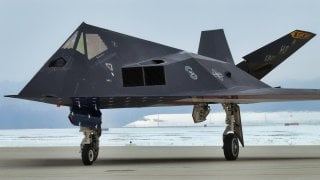The F-117 Nighthawk Proved Stealth Doesn't Mean Invisible
The F-117 Nighthawk, the first operational stealth aircraft, emerged as part of the U.S. Air Force's strategy to evade Soviet air defenses. Debuting in 1981 and operational by 1983, this stealth bomber, equipped with two General Electric engines, prioritized low observability over high speed.
Summary: The F-117 Nighthawk, the first operational stealth aircraft, emerged as part of the U.S. Air Force's strategy to evade Soviet air defenses. Debuting in 1981 and operational by 1983, this stealth bomber, equipped with two General Electric engines, prioritized low observability over high speed.
-Despite its design to reduce radar detection, the F-117's stealth was compromised in 1999 when Serbian forces successfully shot it down. This incident underscored that while stealth technology reduces radar visibility, it does not render aircraft invisible.
-The F-117 was retired in 2008 but remains a significant milestone in aviation and military technology.
The F-117 Nighthawk: A Look Back at America's First Stealth Aircraft
With Great Power Competition between the United States and near-peer adversaries like China and Russia on the rise, large-scale warfare is very much back on the table.
The counterterrorism and counterinsurgency campaigns of the Global War on Terror (GWOT) are over. As such, special operations forces and specialized operations are on the back burner, while large-scale conventional fighting is back at the forefront.
In a potential near-peer conflict, stealth technology will be key. The ability to strike undetected would be an important advantage for military commanders. But how did stealth come to be? What was the first operational stealth aircraft?
The First Stealth Aircraft: The F-117 Nighthawk
The answer is the F-117 Nighthawk.
Part of the U.S. Air Force’s plan to counter Soviet air defenses, the F-117 Nighthawk first flew in 1981 and reached an operational capability two years later in 1983.
The stealth bomber had a range of more than 1,000 miles and could carry both conventional and nuclear munitions.
Powered by two General Electric F404-F1D2 engines that could produce a combined thrust of approximately 21,000 lbs, the F-117 Nighthawk could reach speeds of close to 700 miles per hour. Clearly, to evade enemy air defenses, the aircraft relied on stealth rather than speed, as several aircraft of the period could easily reach speeds of more than 1,500 miles per hour.
The first operational stealth aircraft saw combat in Panama in 1989, in Iraq in 1991, in Yugoslavia in 1999, in Afghanistan in 2001, and finally in Iraq in 2003.
The Air Force retired the stealth bomber in 2008.
F-117 Stealth and the 1999 Incident
To be clear, stealth doesn’t mean invisible. Stealth aircraft are very much visible to the naked eye. Instead, stealth technology makes an aircraft less observable to radar through a combination of technology, aircraft design, countermeasures, and flying techniques.
For example, the F-22 Raptor, the first stealth fighter jet, relies on a combination of special low-observable paint and design to reduce its radar signature. When it comes to design, the F-117 Night Hawk’s sharp lines made it harder for radar to ping it. Harder but not impossible, as the U.S. Air Force found out the tough way on a spring evening in 1999.
On March 27, 1999, the Serbian air defenses were on alert for an incoming wave of NATO aircraft. The Serbian soldiers led by Colonel Zoltan Dani fired a salvo of two S-125 Neva/Pechora surface-to-air missiles against an incoming flight of aircraft.
But on the other side of the engagement was an F-117 Nighthawk (codename “Vega 31”) flown by Lt. Colonel Patrick “Dale” Zelko. The first missile missed the stealth aircraft, but the second detonated close enough to shred it with flak, downing it.
The pilot managed to eject and was rescued a few hours later by Air Force special operators.
If you visit the aviation museum in Belgrade today, you will see the F-117 Nighthawk’s canopy, ejection seat, and wing, a memento of an unforgettable night.
About the Author
Stavros Atlamazoglou is a seasoned defense journalist specializing in special operations and a Hellenic Army veteran (national service with the 575th Marine Battalion and Army HQ). He holds a BA from the Johns Hopkins University and an MA from the Johns Hopkins’ School of Advanced International Studies (SAIS). His work has been featured in Business Insider, Sandboxx, and SOFREP.
All images are from Shutterstock.


